This post contains affiliate links.
Games about the solar system never fail to fascinate the young and the old. And I found various games that can support this interest which includes boards, cards and space-themed toys and activities.
Out of the 18 solar system games I discovered, I recommend
- 3 strategy games and 2 quiz games that cover in-depth space knowledge but need adult supervision
- 2 Monopoly- inspired board games that teach planet names and other space terms
- 5 memory matching games that use actual NASA images
Solar System Games Comparison Table
In school, children study the Earth and space science from pre-school to Grade 8 level. Most of the games in this list appeal to children aged 10 years old and below.
| Game | Type | Age | Players | For | Rating |
| Solar Quest | Board | 8+ | 1-8 | Families | ★★★☆☆ |
| Space-opoly | Board | 8-12 | 1-6 | Families | ★★★★☆ |
| Xtronaut 2.0 | Board | 9+ | 1-6 | Families | ★★★☆☆ |
| Space Exploration | Card | 5-8 | 1-4 | Families | ★★★☆☆ |
| Playful Planets | Card | 7+ | 1-2 | Families, Teachers | ★★☆☆☆ |
| Space Matching Game | Card | 4+ | 1-4 | Families, Teachers | ★★★★☆ |
| Solar System Playing Cards | Card | 12+ | 1-4 | Families | ★★★☆☆ |
| Can Do! Solar System Game | Card | 7-9 | 1-4 | Teachers | ★★★★☆ |
| Space Junior Explorer | Card | 6-9 | 1-4 | Families | ★★★☆☆ |
| Professor Noggin Outer Space | Card | 7+ | 1-8 | Families | ★★★☆☆ |
| Space Top Trump Cards Game | Card | 7-15 | 1-4 | Families | ★★★☆☆ |
| Astronomy Fluxx | Card | 8-15 | 1-6 | Families | ★★★☆☆ |
| Stellar | Card | 12+ | 1-2 | Families | ★★★☆☆ |
| Astronauts | Card | 9+ | 1-5 | Families | ★★★☆☆ |
| Professor Astro Outer Space Flashcards | Flashcard | 7-10 | 1-5 | Families, Teachers | ★★★☆☆ |
| Space Flashcards | Flashcard | 4-6 | 1-2 | Families | ★★☆☆☆ |
| Qurious Space STEM Flashcard Game | Flashcard | 5+ | 1-18 | Families | ★★★★☆ |
| Solar System Spy Puzzle with Flashcards | Puzzle with Flashcard | 4-9 | 1-4 | Families, Teachers | ★★★★★ |
| Apollo Mission | Card | 12+ | 1-5 | Families | ★★★☆☆ |
| Space Team | Card | 12+ | 1-6 | Families | ★★★☆☆ |
| Space Explorers | Activity | 4-9 | 1-3 | Families, Teachers | ★★★★☆ |
| Space Darts | Toys | 4-8 | 1-3 | Families, Teachers | ★★★☆☆ |
| Magnetic Playset-Solar System | Board | 3-8 | 1-4 | Families, Teachers | ★★★☆☆ |
Solar System Board Games
In this section, I list 3 board games that can be enjoyed at home.
Solar Quest (Universal Toys)
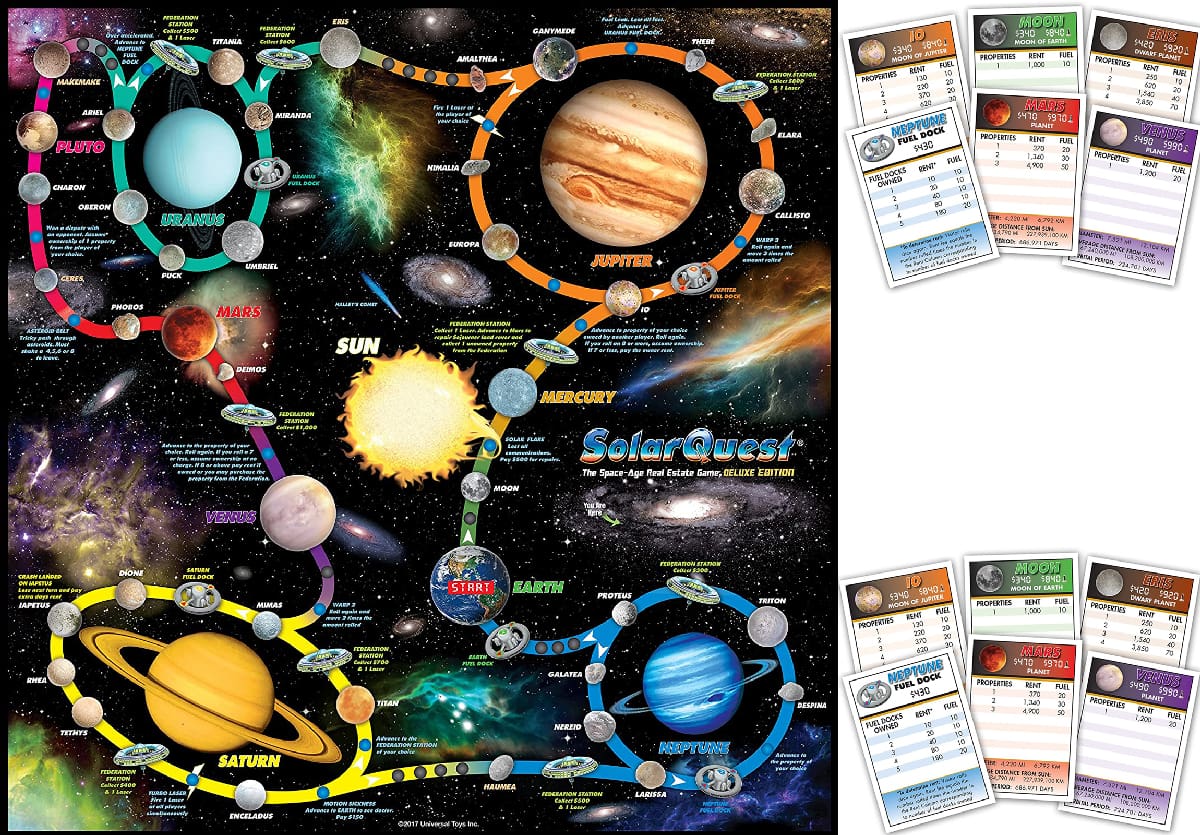
★★★☆☆
For Families | Age 8+ | 1-8 Players | Price $$$ | Author: Valen Brost
In Solar Quest, players compete to build the largest financial empire by purchasing moons and planets and collecting rent from them while avoiding bankruptcy, being stranded in space or losing in a laser battle.
players compete to build the largest financial empire by purchasing moons and planets and collecting rent from them while avoiding bankruptcy, being stranded in space or losing in a laser battle.
The gameplay seems familiar, but it is actually more complex than Monopoly. When Valen Brost published this game in 1985, he replaced hotels with metallic fuel stations and pewter tokens with rocket ships. The redshift cards made the flight path unpredictable and challenging.
In the 2017 Deluxe edition, the redshift cards were gone. it consists of:
- Fuel Tank Hydrons card
- Mission cards
- Fuel Dock cards and stations
- Dice, Rocket ships, Play money, Laser chips
This game has two levels of gameplay:
- Easy level– suited for children aged 8 to 14 years old because they do not need to manage and pay for fuel to move on the game board
- Advanced game includes fuel monitoring and other special rules that upset young players like
- Going bankrupt due to fuel charges and rent
- Landing on the space occupied by another player hence triggering a laser battle (one of the players is eliminated from the game when this happens)
- Being stranded on space due to lack of fuel
The inclusion of fuel management encourages players to develop strategies.
The pros of this game include:
- Players become familiar with various cosmic bodies and learn space related terms
- This game is luck-driven (everybody has a chance to win)
- Players can choose to stay orbiting the planet until they acquire desired moons, planets and fuel stations
- Players can win by completing secret missions
- Players can trade mission cards (players can choose which missions to accomplish)
The cons of this game:
- The cards do not contain enough information about planets, moons and more (they could’ve used the reverse side of the card to make the game more educational)
- The game is broken if players assign a planet to orbit or keep their fuel low to stay in the same orbit where they feel safe
By the way, the Deluxe edition has similar gameplay with the “Solar Quest: Mission to Mars” edition but with 6 players only.
Overall, Solar Quest is fun and challenging but does not offer in-depth knowledge about the solar system.
Space-opoly (Distributions Solutions LLC)

★★★★☆
For Families | Age 8 to 12 | 1-6 Players | Price $$
Another board game that is patterned after Monopoly is Space-opoly . Players have four ways to win:
. Players have four ways to win:
- Completing the mission
- Winning the laser battle
- Being the last player on the board
- Having the most assets
This space-themed board game is comprised of:
- A gameboard
- 6 plastic rocket ships, 2 dice, 36 color-coded tokens (6 per color)
- 36 Property deed
- 36 laser tokens
- 20 mission cards
- Solar play money
As players advance their rocket ships on the gameboard, players become familiar with concepts like:
- Astronauts
- Planets, Sun
- Asteroid, Meteor, Comet
- Quasar, Black hole
- Eclipse
- Nebula
- Northern Lights
- Supernova
- Gravity
- Milky Way galaxy, Spiral galaxy, Sombrero galaxy
- Telescope, Hubble Telescope
I like this game because:
- Players learn information about astronomical bodies such as:
- Pronunciation
- Short description
- Diameter
- Average distance from the planet
- Orbital period
- The gameplay is unpredictable and less serious than Solar Quest
- Players can win even though were low on money and property by completing Mission cards
- When players land on Earth, they can swap mission cards or collect $500 from the bank
The rules that frustrate young players are:
- Rolling a double six eliminates the player from the game through laser battle (quick elimination)
- When the player is out of money, they cannot sell or trade properties except to the player they owe a debt
- Landing on black dots which represent gravitational pull of the planet prevents the player from leaving the orbit unless they roll a number that lets them move past these spaces
Overall, I recommend SpaceOpoly for 8 to 12-year-old children because it is easy to set up and learn, and there is good educational content.
Xtronaut 2.0 (Xtronaut Enterprises, Inc.)
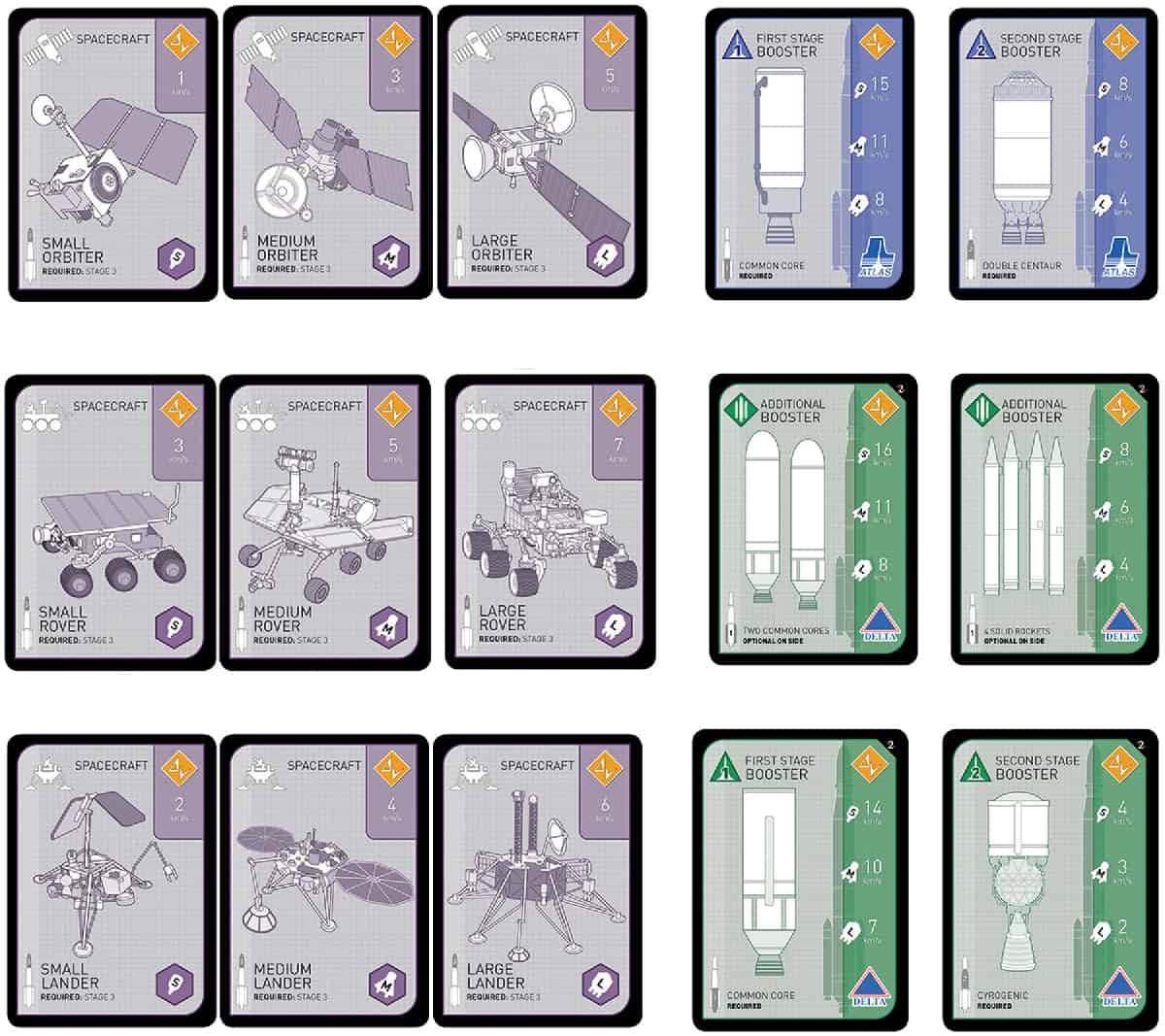
★★★☆☆
For Families | Age 9+ | 1-6 Players | Price $$$ | Author: Professor Dante Lauretta
Xtronaut 2.0 was created by Professor Dante Lauretta, the leader of the OSIRIS-REX Space Mission which aims to collect an asteroid sample from the surface of Bennu and return it to Earth in 2023.
was created by Professor Dante Lauretta, the leader of the OSIRIS-REX Space Mission which aims to collect an asteroid sample from the surface of Bennu and return it to Earth in 2023.
In this game, players learn various space missions that are based on real science and events. Each mission has an equivalent point. The first player to obtain 10 points is the winner.
The game contains:
- a workbook about space missions
- 6 player boards
- 1 First Player token, 6 score tokens
- 1 six-sided die
- 30 Mission Hexes
- 42 Action cards
- 123 playing cards (25 Atlas vehicles, 25 Delta vehicles, 22 Falcon vehicles, 15 SLS vehicles, 18 Gravity Assists, 18 Spacecrafts)
Three phases are repeated until the mission is completed:
- Phase 1 -At the start of the game, each player is dealt with 5 playing cards which they trade for action cards.
- Phase 2– Do the instruction on the action card.
- Phase 3– Trade cards to get the components needed in the mission.
This game scored three stars for:
- Intricate details placed on game pieces which make the space mission simulation convincing and entertaining
- Action cards develop the player’s ability to follow instructions carefully and strategize
- Players learn space exploration terms and the name of the space missions
- Players can work on the mission cooperatively while managing the player boards separately
- Repeating the gameplay improves the players’ concentration and space mission knowledge
The cons of the game include:
- The cards can be overwhelming to learn (overflowing with space exploration ideas)
- It requires a lot of reading (the texts are small and young players need adult supervision)
- Players need to monitor plenty of components (mission card, Delta Force to launch the rocket, vehicle to use and points earned)
- The experience is more fun with 6 players than alone or with 2 players
Solar System Card Games
Space Exploration (Eeboo)
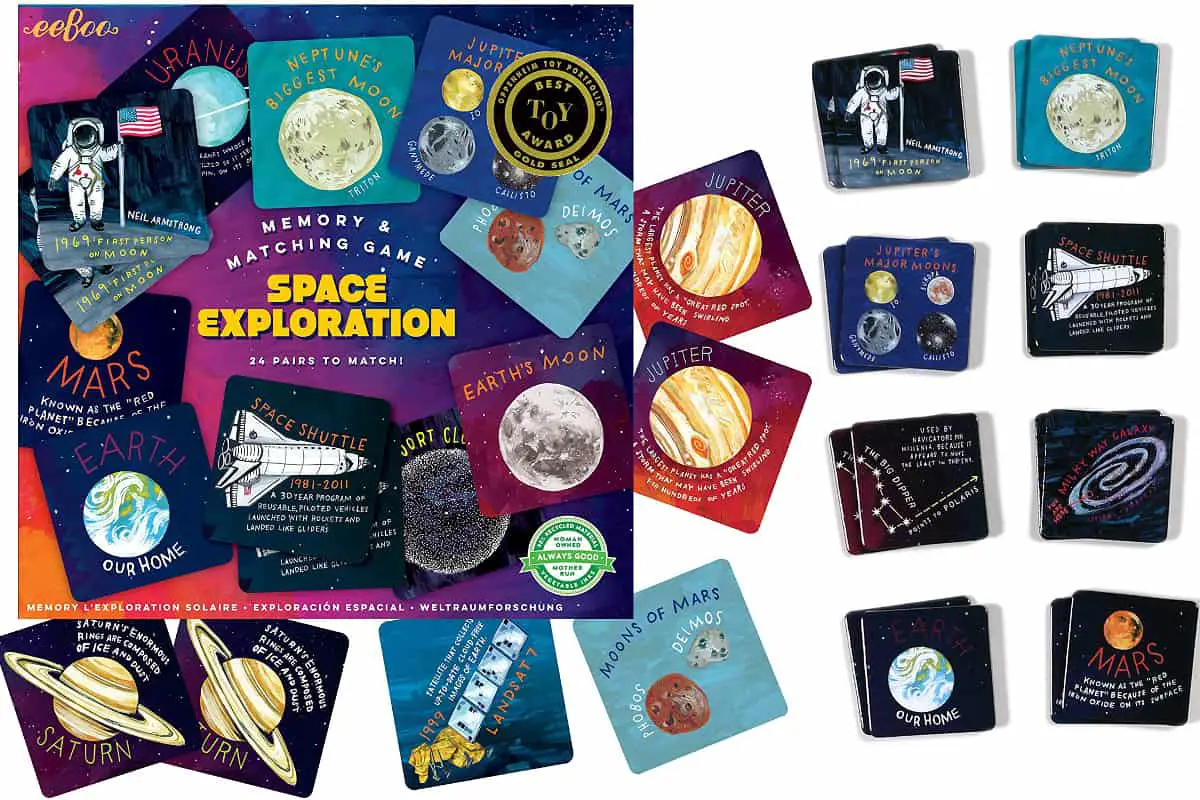
★★★☆☆
For Families | Age 5 to 8 | 1-4 Players | Price $$
Space Exploration is a matching game with 48 cards (24 pairs) that are beautifully illustrated with various cosmic bodies and fun space facts.
is a matching game with 48 cards (24 pairs) that are beautifully illustrated with various cosmic bodies and fun space facts.
The good points are:
- The cards are colorful, thick and easy to turn over
- The quality of pictures is great
- Players are introduced to easy to digest information about planets, their moons and space exploration.
Playful Planets (Playful Planets)
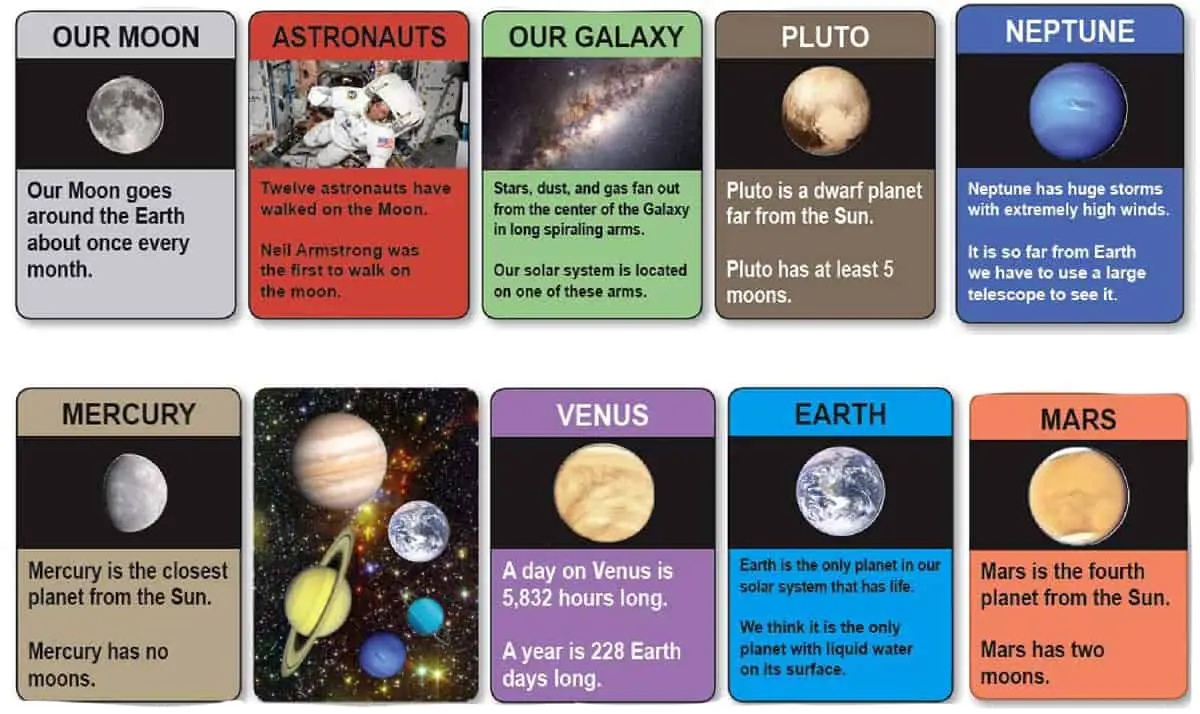
★★☆☆☆
For Families | Age 7+ | 1-2 Players | Price $$
Playful Planets offers 10 different rules with increasing difficulty which include classic ones such as Go Fish, Old Maid, Bingo, Slap Jack, and two original rules. The 52 cards feature planets, moons, sun, and other interesting space information.
offers 10 different rules with increasing difficulty which include classic ones such as Go Fish, Old Maid, Bingo, Slap Jack, and two original rules. The 52 cards feature planets, moons, sun, and other interesting space information.
Texts on the cards are large and readable, but some contain incorrect information.
- Pluto is a gas giant planet (It is not, it resembles terrestrial planet but made of ice and rock)
- Saturn is made mostly of icy water and rock (It is a gas giant made mostly of helium and hydrogen)
- Uranus’ summer is 42 Earth years long. (Each season on Uranus lasts 21 earthly years.)
Because of this major blunder, I only give two stars.
A future edition might correct this problem, which would be great.
Space Matching Game (Chronicle Games)
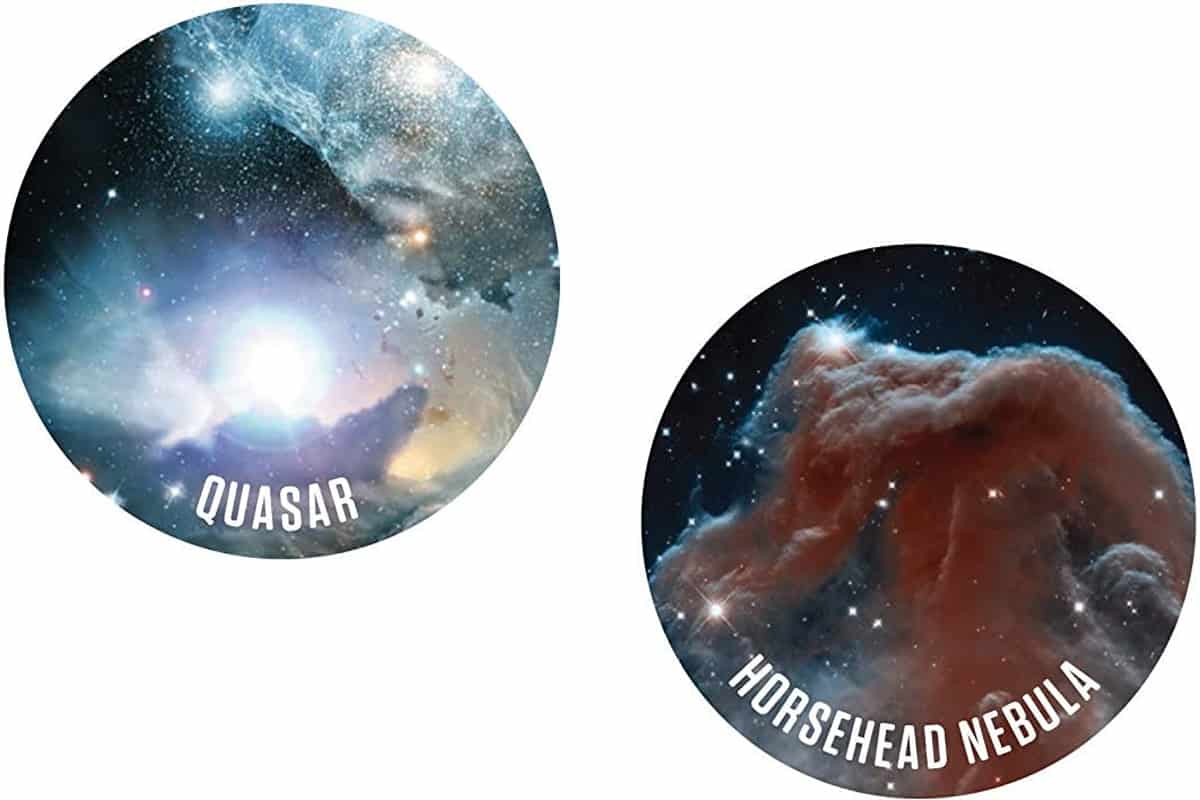
★★★☆☆
For Families and Teachers | Age 4 to 6 | 1-4 Players | Price $$
Space Matching Game is a memory matching game that uses images from NASA archives.
is a memory matching game that uses images from NASA archives.
It has 52 round cards that are fantastic for solo play. If played with 2-4 players, completing 26 pairs of astronomical bodies and other space objects takes about 5-10 minutes.
I like this set because
- The photos are high quality, with readable labels.
- Children learn to match planets, comet, space objects and historic space events.
Although the gameplay is simple, children will not get bored easily because the pictures are captivating. The game works well for introducing space terms and events.
Solar System Playing Cards (Brightstar Astronomy)
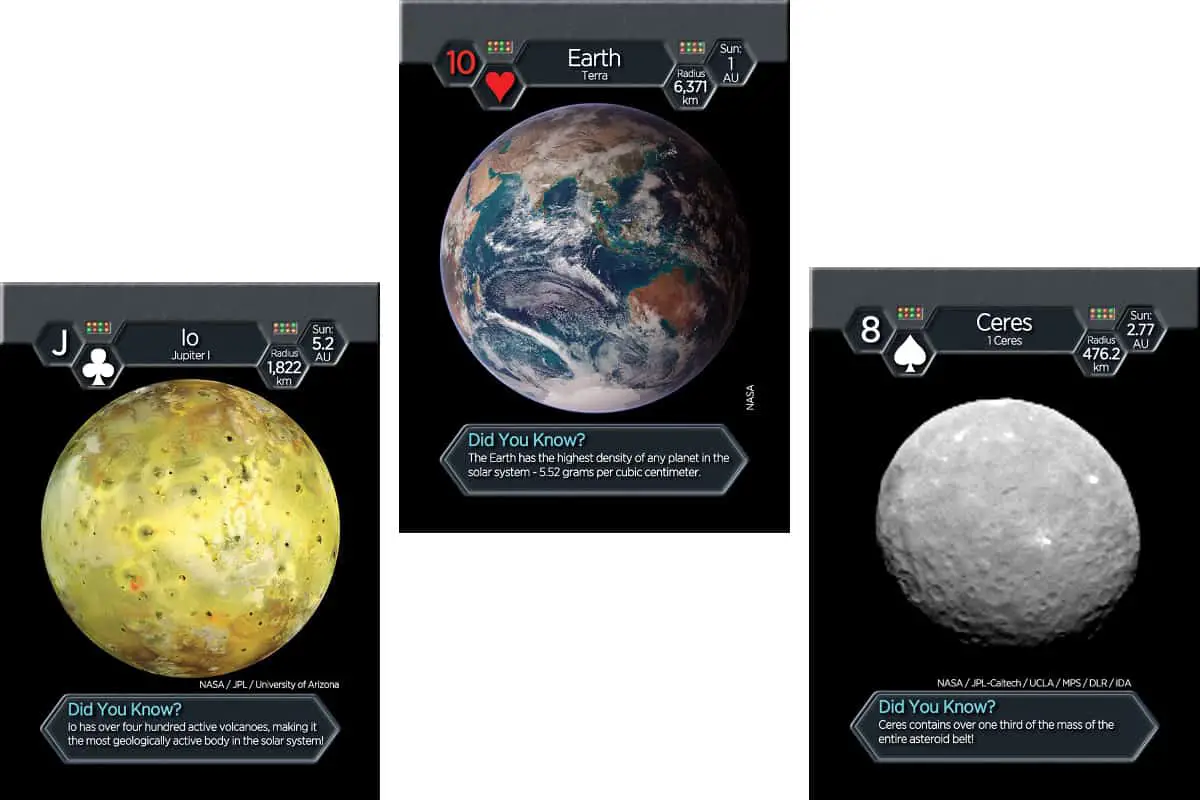
★★★☆☆
For Families | Age 12+ | 1-4 Players | Price $$
Solar System Playing Cards  is a multi-purpose deck of cards filled with interesting information about the Solar system.
is a multi-purpose deck of cards filled with interesting information about the Solar system.
It consists of 54 cards that are divided into four suits:
- The Sun (and solar features)
- Planets (and planetary features)
- Moons of the solar system
- Minor solar system bodies (dwarf planets, Kuiper Belt objects, asteroids, comets)
Players will enjoy this card set because:
- The images are clear and of good quality (taken from NASA)
- It works as quiz cards, trump cards or solitaire.
Although the labels on top of the card are confusing at first, each piece of information can be used as a category in a game.
The trivia in each card is helpful for students aged 12 years old and older.
Can Do! Solar System Game (Lakeshore Learning)
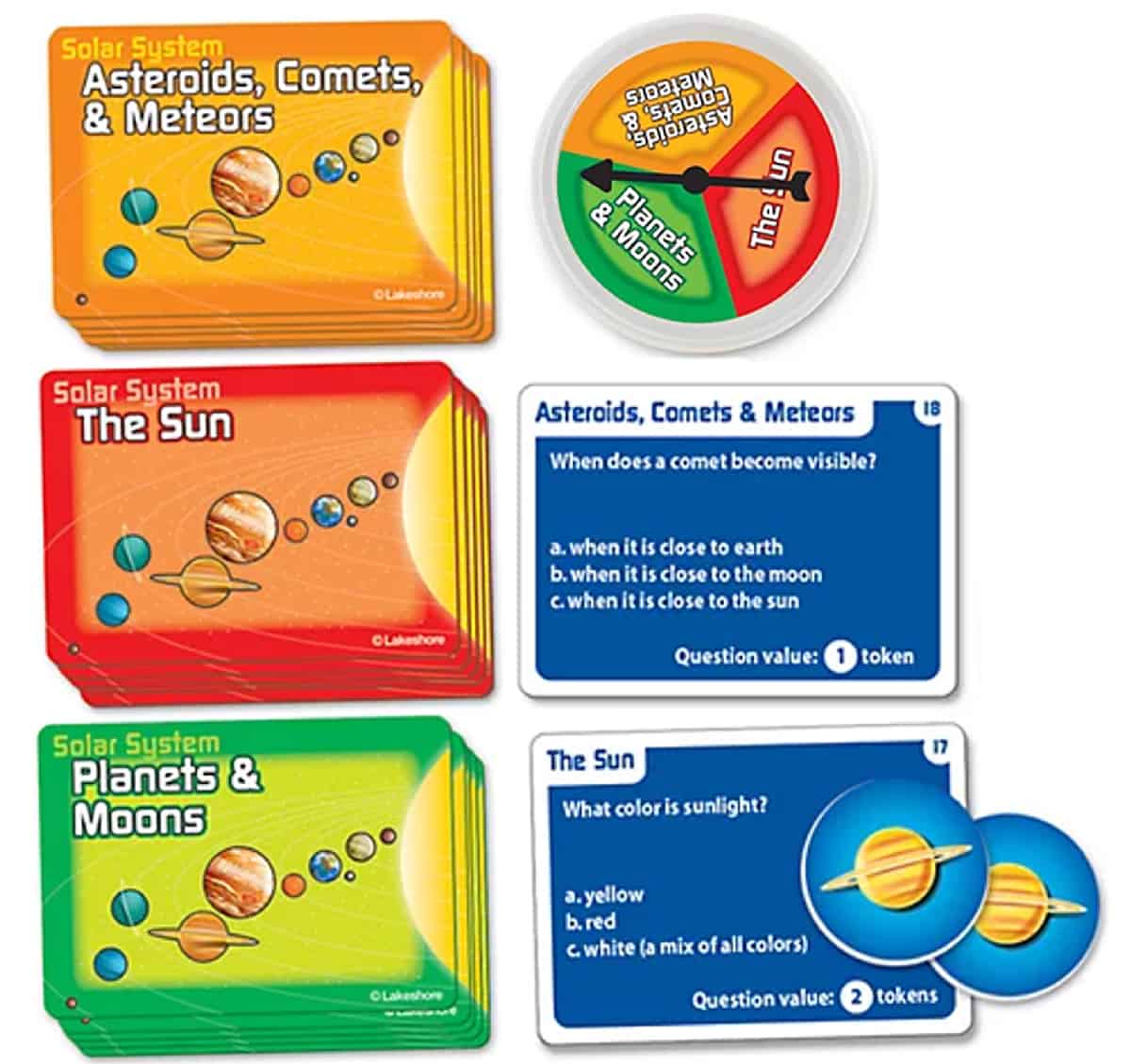
★★★★☆
For Teachers | Age 7-9 | 1-4 Players | Price $$ | Grade 2 – 4
In Can Do! Solar System Game , children collect space-themed tokens as they compete to answer questions based on the Solar System. The player with the greatest number of tokens wins the game.
, children collect space-themed tokens as they compete to answer questions based on the Solar System. The player with the greatest number of tokens wins the game.
The game contains
- A canister that has a spinner built on the lid
- Game tokens
- 60 self-checking question cards that are divided into the following categories:
- The Sun
- Planets and Moon
- Asteroids, Comets and Meteors
I like that:
- The questions are easy to understand
- Choices are available
- Although the use of tokens makes the game competitive, teachers can group students in pairs to help each other answer the questions.
- The difficulty of the question is determined by the token value on the card
- The game is easy to play and the chance to build space knowledge is high
I recommend playing this game in the classroom with children aged 7 to 9 years old.
Space Junior Explorer (Reveal Cards LLC)
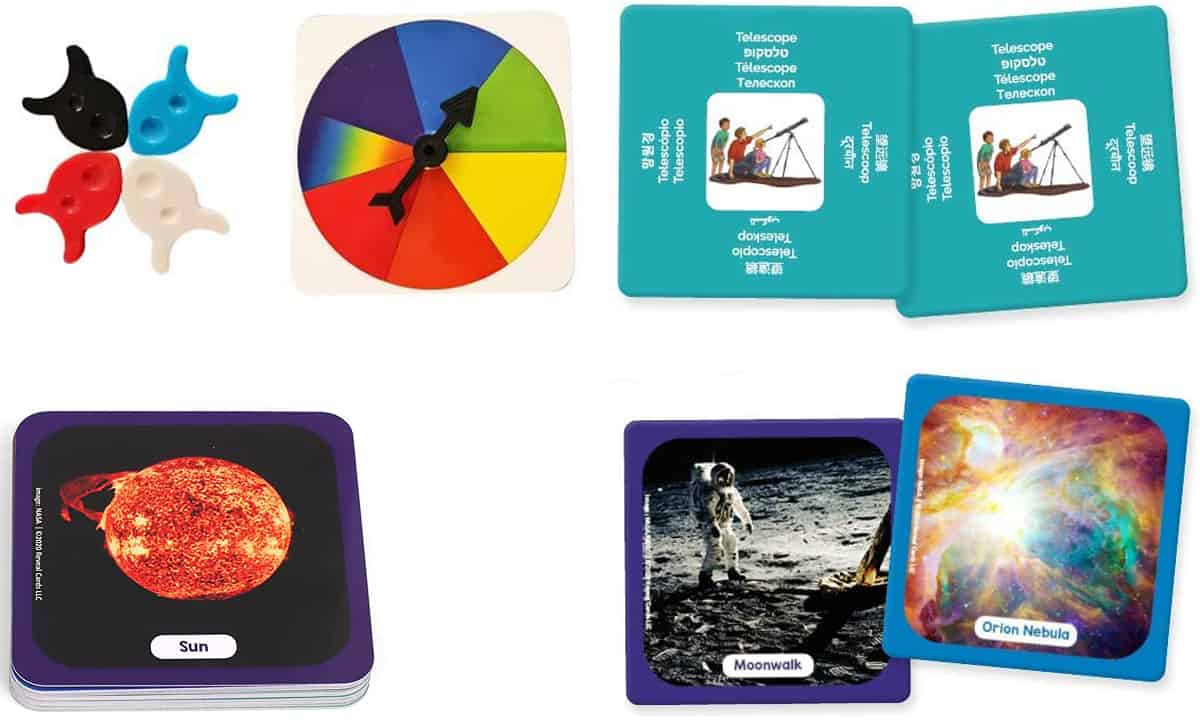
★★★☆☆
For Families | Age 6 to 9 | 1-4 Players | Price $$
Space Junior Explorer can be used as a memory matching game or as an adventure game.
can be used as a memory matching game or as an adventure game.
It has
- 50 double-sided cards (memory and explore cards)
- 1 spinner
- 4 rocket-shaped playing tokens
The strong points of this card set are:
- It features original NASA space photos
- The cards are easy to use
- The rocket ships and spinner help players create their own space adventure
The problems I found in this game include:
- As soon as players become familiar with the terms and photos, the game becomes stale
- Players do not gain enough knowledge about the solar system
The terms are available in 14 languages such as Korean, Greek, Arabic and more.
Professor Noggin Outer Space ( Outset Media)

★★★☆☆
For Families | Age 7+ | 1-8 Players | Price $
Professor Noggin Outer Space is an educational game where players take turns in quizzing each other about the Solar System.
is an educational game where players take turns in quizzing each other about the Solar System.
The player who got the correct answer keeps the card. The player with the greatest number of cards is the winner.
This game has 30 illustrated question cards and a die.
Each card has 6 questions (180 questions in total) that differ in difficulty (3 levels) and format. It contains questions such as:
- True or false
- Multiple Choice
- Trivia
The answers are found at the bottom of the card.
I like this game because
- There are two levels of gameplay
- Easy (suitable for children aged 7-12 years old)
- Hard (enjoyable for adults)
- The cards are self-checking and labeled clearly
- The game is repeatable
The less good about this game:
- This game is more enjoyable for players with previous space knowledge
- Beginners may suffer from information overload, so it is best to pair them up with players that have better knowledge about the solar system.
Space Top Trump Cards Game (Top Trumps USA)
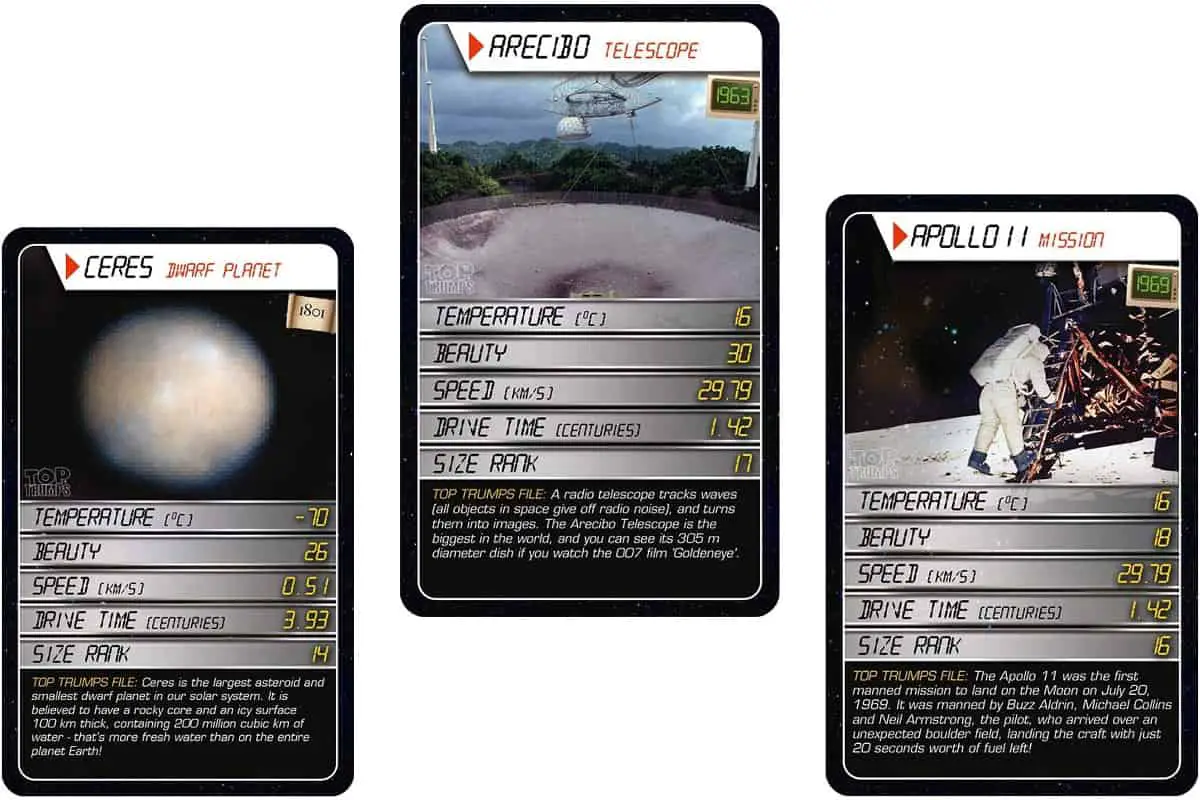
★★★☆☆
For Families | Age 7 to 15 | 1-4 Players | Price $
In Space Top Trump Cards Game, players outsmart each other by choosing the best stat in their card as opposed to the stat in their opponent’s card.
players outsmart each other by choosing the best stat in their card as opposed to the stat in their opponent’s card.
This game has 30 cards that include planets, stars, comets, black holes, and historical space events. The player who keeps all 30 cards wins the game.
Each card has the following “stats”:
- Temperature
- Beauty
- Speed
- Drive time (in centuries)
- Size Rank
My biggest concern in this game is that “beauty” is subjective and the size is not given by a measure but by a rank .
On the other hand, I love the details included in the bottom because they can trigger children’s curiosity to study the solar system further. I think this part will be enjoyed by students aged 12 to 15 years old.
Astronomy Fluxx ( Looney Labs)

★★★☆☆
For Families | Age 8 to 15 | 1-6 Players | Price $$ | Author: Andrew Looney
Astronomy Fluxx contains 100 cards and a rule sheet.
contains 100 cards and a rule sheet.
Here is the breakdown of the cards:
- 19 Keeper Cards
- 36 Goal cards
- 26 New Rules cards
- 18 Action cards
At the start of the game, players are dealt with three cards. During their turn,they follow the basic rule which is to draw 1 card and play one card.
Players deal with four types of cards:
- New Rules– changes the player’s strategy because it takes effect immediately after it was drawn; must be placed face up at the center of the table
- Keeper– players must collect these cards to win the game; must be placed face up in front of the owner of the card
- Goal –indicate the keeper card needed to win the game; shown face up at the center of the table
- Action- goes to the discard pile once done
The player who meets the conditions of the goal wins the game.
The pros of this game are:
- It uses real NASA photos and provides some useful information
- Exciting (the rules change as you play)
- Repeatable (the experience is always different in each game)
- Players may join and exit the game anytime
- Players can keep playing by shuffling the discard pile and use it as the new draw pile
Some of the notable actions in this game are:
- Naming a constellation
- Orbiting the planets
- Supernova
The cons are:
- Gameplay involves reading a lot
- Not all cards are informative
- Playtime ranges from 5 to 45 minutes.
Stellar (Renegade Game Studios)
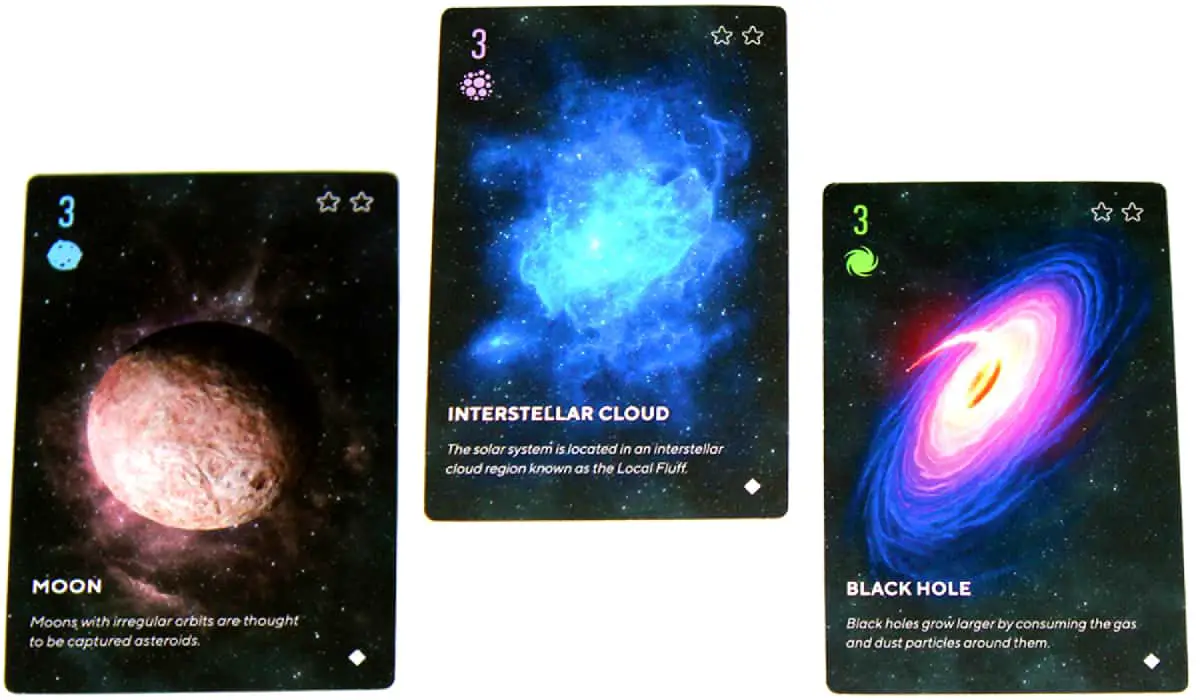
★★★☆☆
For Families | Age 12+ | 1-2 Players | Price $$
Stellar is a strategic 2-player game that can be played within 30 minutes.
is a strategic 2-player game that can be played within 30 minutes.
It comprises:
- 24 telescope cards (12 cards for each color: blue and pink)
- 60 yellow celestial object cards
- 5 number cards
- 2 reference cards
- scorepad, rulebook
Cards use actual photos of moons, planets, asteroids, interstellar clouds and black hole.
To win, players must collect high scoring cards. There are three ways to obtain the highest final score:
- Stars and multipliers
- Section majorities
- Diversity bonus
The cards contain high-quality photos and straightforward explanation of terms for planets, moons, asteroids, interstellar clouds, and black holes
But:
- It occupies a lot of space.
- The rules, mechanics and scoring are very complicated (see the video below by Game Boy Geek for more details) but can be enjoyed by really engaged players
Astronauts (Wildcard Games)
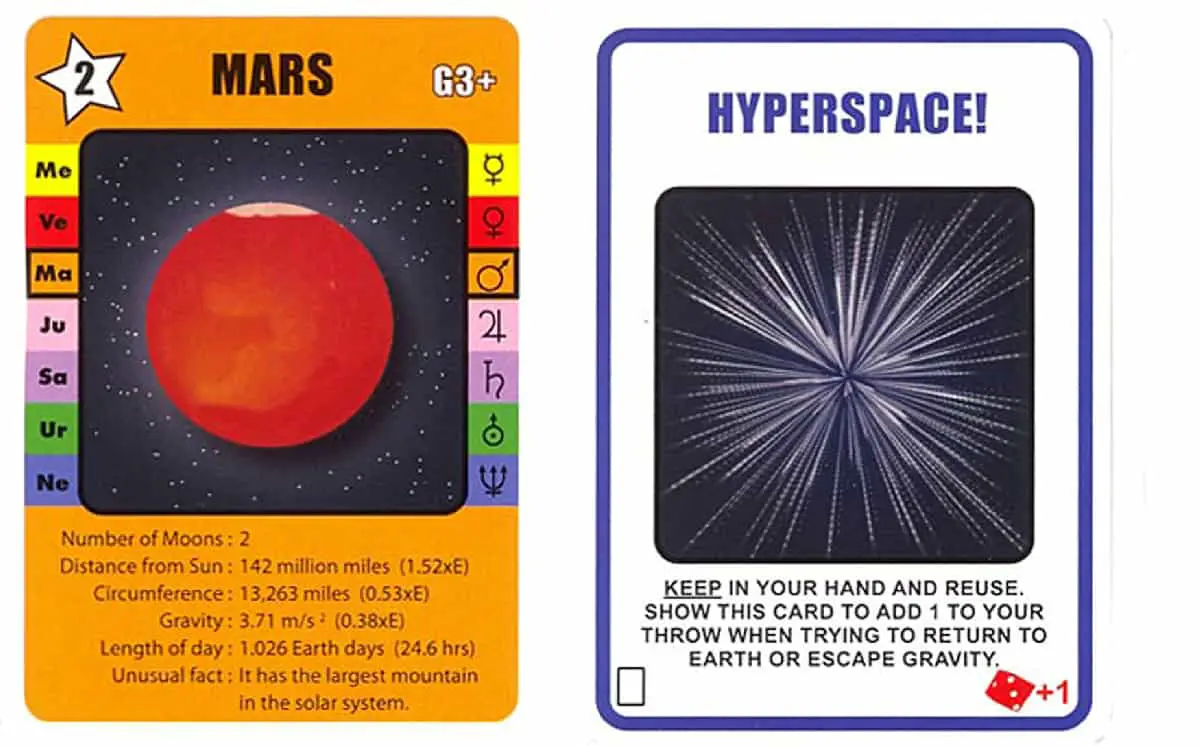
★★★☆☆
For Families | Age 9+ | 1-5 Players | Price $$
In Astronauts, players visit various cosmic bodies as they aim to return safely to Earth. Each planet carries a numerical value where
players visit various cosmic bodies as they aim to return safely to Earth. Each planet carries a numerical value where
- Planets farthest from the Earth score up to 5 points each
- Planets near the Earth earn 2 points
However, such space travel is made challenging by power cards such as:
- Asteroid impact– the player is eliminated from the game
- Comet-double the score of the planet
- Gravity– players get stuck on the planet until they roll a desired dice number
- Space pirates– players switch cards
- Wormhole– switches the draw and discard piles
This game consists of:
- 20 planet cards
- 9 moon cards
- 3 dwarf planet cards
- 8 return to earth cards
- 16 special cards
- Dice & rule sheet
The strong points of this game include:
- Fun and easy to learn
- Children learn the planet names, order and might learn other facts about celestial bodies in the solar system
- The game depends on luck and does not require previous space knowledge
Some things could have been improved:
- Instructions are confusing (for example, it says “shake the dice” instead of “roll the dice”, doesn’t specify where the 5 starting cards should come from)
- The playing time is 45 minutes.
Solar System Flash Cards
Professor Astro Cat’s Outer Space Flash Cards (Clarkson Potter)
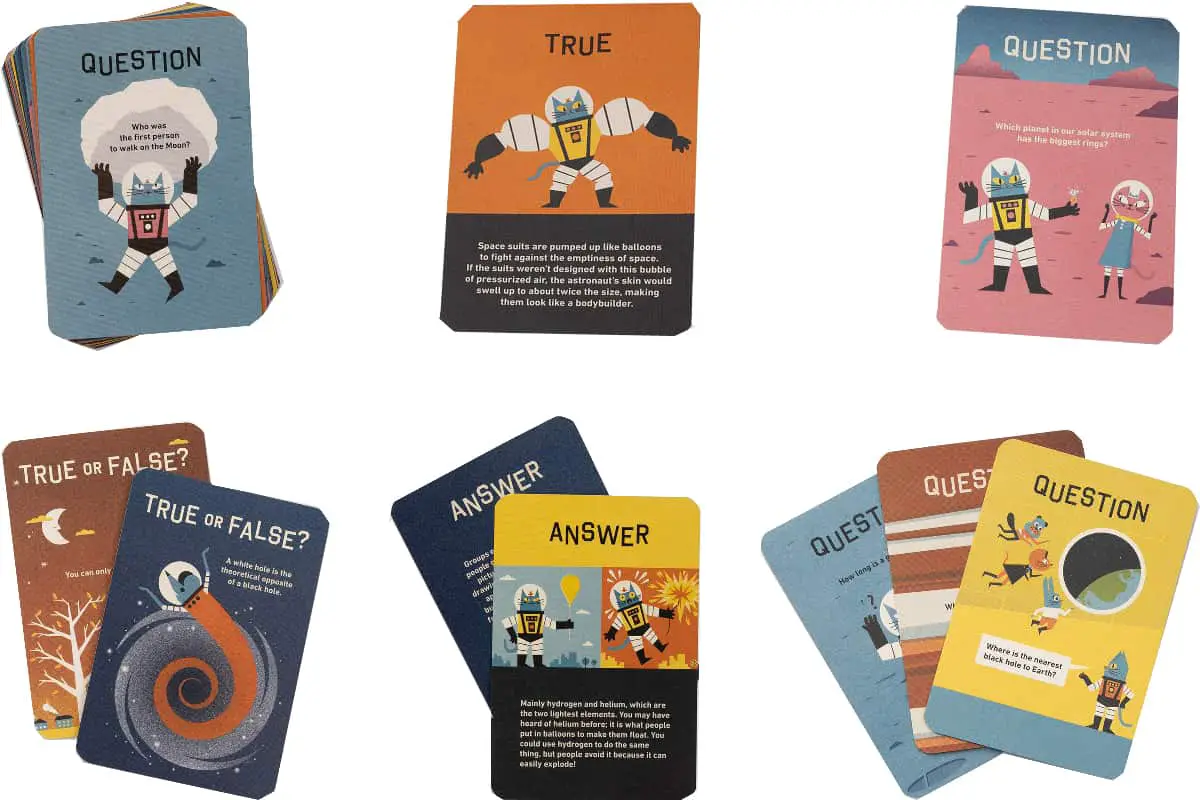
★★★☆☆
For Families | Age 7 to 10 | 1-5 Players | Price $$ | Authors: Dr. Dominic Walliman and Ben Newman
Professor Astro Cat’s Outer Space Flash Cards is based on the popular book “Professor Astro Cat’s Frontiers of Space “which was written by Dr. Dominic Walliman.
is based on the popular book “Professor Astro Cat’s Frontiers of Space “which was written by Dr. Dominic Walliman.
It contains 50 flashcards that have varied types of questions such as:
- Why questions
- True or False
The cards are educational (trivia and answers are provided) and the text easy to read, but 7–10-year-old children will need adult supervision in understanding the information on the cards (some information requires lengthy explanation).
Space Flashcards (Chronicle Books)

★★★☆☆
For Families | Age 4 to 6 | 1-2 Players | Price $$
Space Flashcards features 20 actual NASA images of
features 20 actual NASA images of
- Planets (Earth, Jupiter, Mars, Mercury, Neptune, Saturn, Uranus and Venus)
- Moon
- Sun
- Pleiades
- Quasar
- Butterfly & Tarantula Nebula
- Solar Eclipse
- Andromeda Galaxy
- Apollo 11
- Hubble Space Telescope
- International Space Station
- Mars Rover
The photos are high quality, but the cards could be more educational (little information, just good for memorizing terms!), so they are good for small children only.
Solar System Spy Puzzle with Flashcards (Vevoo)

★★★★☆
For Families and Teachers | Age 4 to 9 | 1-4 Players | Price $$
In Solar System Spy Puzzle with Flashcards, players can enjoy two games in one game set:
players can enjoy two games in one game set:
- 48 huge puzzle pieces & a magnifying glass to find hidden astronomical bodies on the puzzle
- 20 flashcards with simple photos of space objects and facts on the back.
In the spy puzzle, children can search:
- 9 aliens
- 4 asteroids
- 5 astronauts
- 3 comets
- 4 rovers
- 4 satellites
- 4 space shuttles
- 4 UFOs
The good points of this game are:
- The replayability is high
- Encourages interaction among players
- Good for independent and cooperative play
The game design is very good:
- Excellent quality of the game pieces (the magnifying glass is captivating for children)
- The cards are simple but packed with information
- The illustrations are real images
- Can be used as learning tools in introducing the solar system in the classroom
The spy puzzle requires a lot of space space though!
I recommend the flashcards to be played as quiz cards with children aged 5 to 9 years old while the spy puzzle is suited for children aged 4 to 8 years old.
Qurious Space STEM Flashcard Game (Qurious)
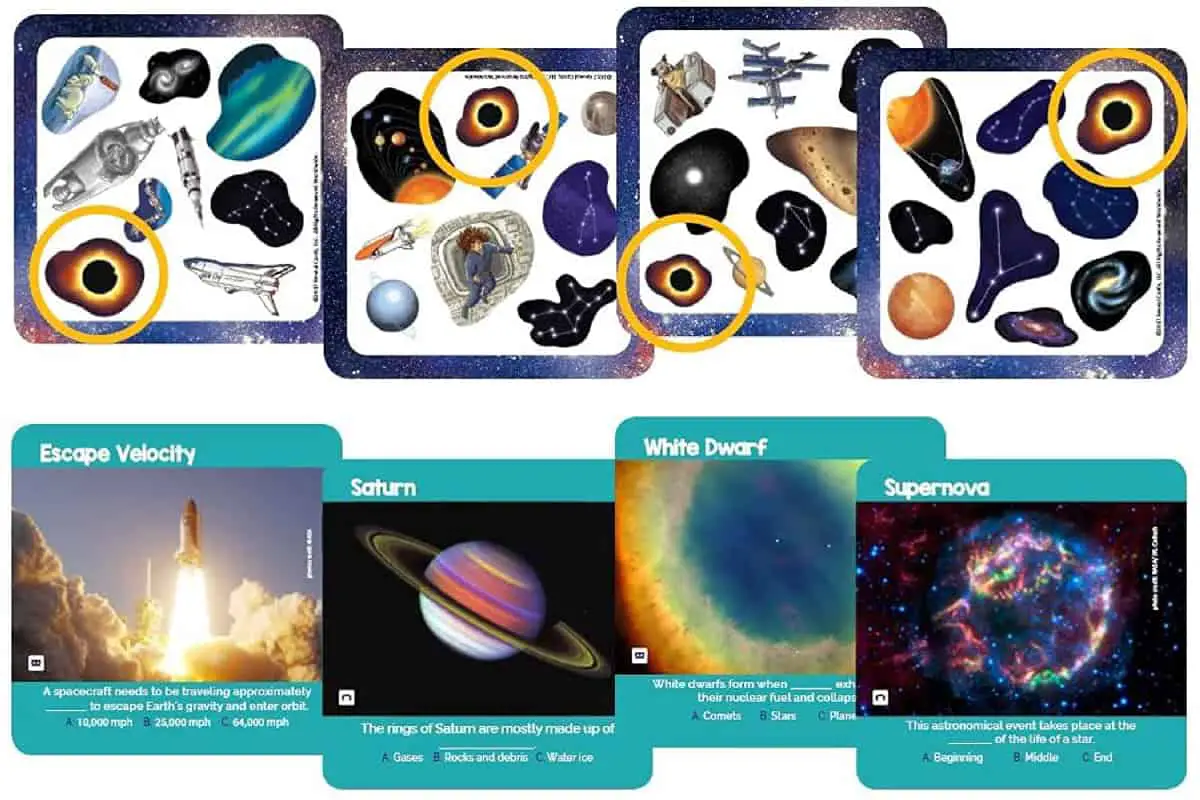
★★★☆☆
For Families | Age 5+ | 1-18 Players | Price $$
Qurious Space STEM Flashcard Game features 72 quiz cards and 72 double-sided cards that can be used as
features 72 quiz cards and 72 double-sided cards that can be used as
- Explore cards
- Matching cards
This flashcard set comes with:
- 18 spin cards
- 4 space stickers
- A sturdy tin
The advantages of using this flashcard set are:
- The cards are colorful and attractive for young children
- The quiz cards are informative, multiple choice questions and are self-correcting
- Players can manage difficulty by removing cards that are easily identified by players
- There are four gameplay variations such as:
- Space speed matching game
- Challenge memory game
- Explorer matching pairs game
- Photo trivia game
The less good about this set are:
- The cards are small, so the photos are tiny
- The texts are not easy to read
Other Space-themed Games, Toys and Activity Sets
Apollo Mission (Buffalo Games)

★★★☆☆
For Families | Age 12+ | 1-5 Players | Price $$
Apollo Mission is a cooperative strategy game designed for five players. One of the players roleplays as mission control while the remaining players act as astronauts.
is a cooperative strategy game designed for five players. One of the players roleplays as mission control while the remaining players act as astronauts.
In this game, mission control tracks the progress of the challenges that must be overcome by the astronauts such as:
- Resolving flight stages
- Repairing systems
- Completing experiments
Inspired by NASA moon missions, this game consists of the following components:
Apollo Mission pack which includes:
- 8 Apollo Flight Stage Cards
- 12 Apollo experiment cards
- Apollo Mission Gameboard
- Apollo Mission Game pawn
Gemini Mission Pack is comprised of:
- 5 Gemini Flight Stage Cards
- 8 Gemini Experiment Cards
- Gemini Mission Gameboard
- Gemini Mission Game pawn
The mission control game pieces include:
- Player screen
- Mission control board with 5 track markers (sliders)
Astronauts in this gameplay with:
- Astronaut control Board
- Flight Damage board
Together they must solve:
- 4 crisis puzzle boards
- 12 crisis puzzle pieces
- 25 crisis cards
Using:
- 20 +- tokens
- 23 comm tokens
- 1 experiment marker
- 5 astronaut markers
- 6 yellow dice
- 6 black dice
- Turn token
- 3 alert light clips
The game guide recommends playing the Gemini mission first so that players will be familiar with the mechanics and strategies needed in the game. The main goal of this game is to develop space travel techniques to support the Apollo Mission and return safely to Earth. This gameplay takes about 30 minutes to finish and there are two experiments that must be completed.
On the other hand, the Apollo mission needs a more experienced crew because the gameplay takes longer to complete (about 45-60 minutes). Players must accomplish 3 experiments.
The pros:
- The game pieces are perfect for the simulation of space missions
- It enriches the imagination of the players as they recreate the historical space mission and learn terms associated with it.
The cons of this game are:
- The operations manual is overwhelming to read
- The missions are time-consuming
- The mechanics are complicated. For example:
- Use black dice only for power distribution
- Yellow dice for life support which is labeled as +- token
- Comm tokens to share flight information
Because of its complex rules, I suggest playing this game with children aged 12 years old and above.
Spaceteam (Stellar Factory)
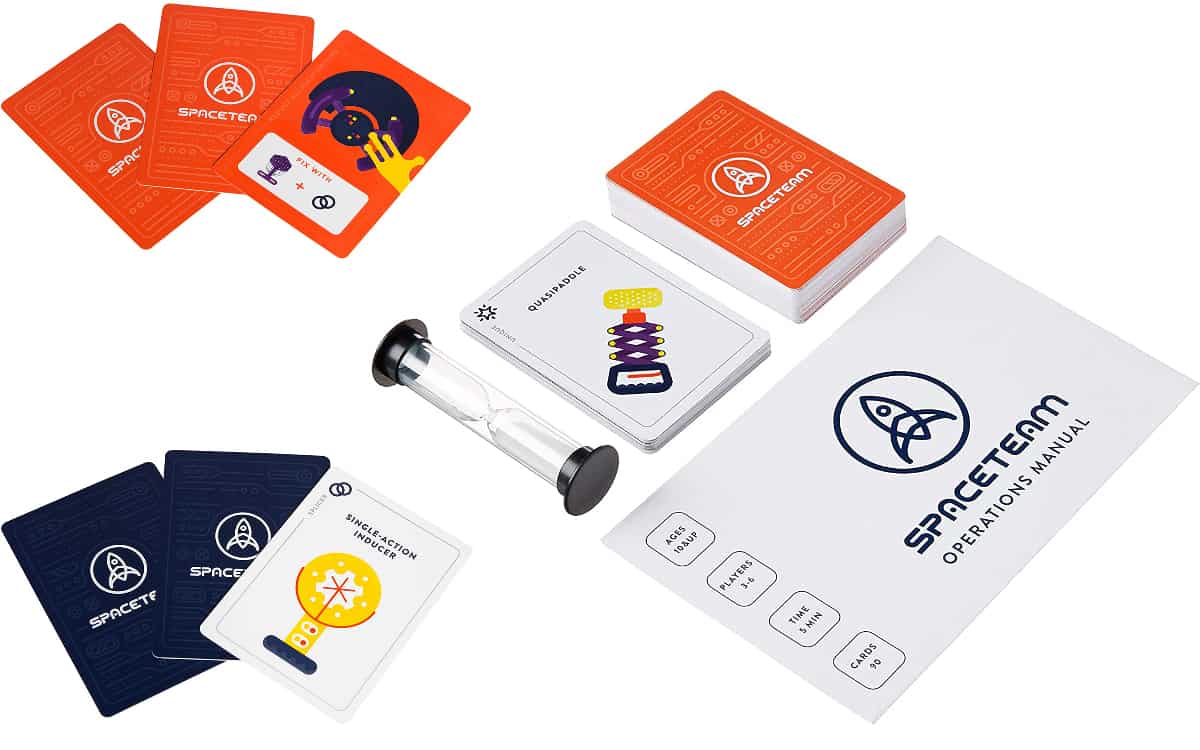
★★★☆☆
For Families | Age 12+ | 1-6 Players | Price $$$
Spaceteam is another cooperative strategy game that can be enjoyed in 5 minutes. That is if you played the game several times and developed the strategies required in the game.
is another cooperative strategy game that can be enjoyed in 5 minutes. That is if you played the game several times and developed the strategies required in the game.
This game is composed of:
- Timer
- Operations manual
- 24 tool cards (blue)
- Orange cards are classified as:
- Malfunction cards (contains a box at the bottom with “fix with” label)
- Anomaly (displays text for instructions)
- Systems go cards (shows a part of the rocket; it tells what part of the ship is fixed)
The goal of the game is to work together in solving the malfunctions and complete all 6 system go cards which when connected forms a rocket.
The good points of this game:
- Has varying difficulty (the difficulty of the gameplay depends on the mix of malfunction, anomaly and systems go cards as suggested in the operations manual)
- Encourages interactive participation among players
- Inspires players to be creative in sharing information though the labels of the tools were all made up
- The game is repeatable, and the experience is different
The less good:
- The mechanics is not easy to learn as promoted (players need to be familiar with the tools to get a hang of it and develop strategy)
- Players shout a lot to get the tool they need because they can only pass the card to the adjacent player (else they cannot move on; I suggest playing in proximity)
- The labels of the tools are not real names of items (it would’ve been more educational if they were real tools)
I recommend playing this party game with 3 to 6 players aged 12 years old and above because this game relies heavily on teamwork to enjoy it.
Skillsmatic Educational Game Space Explorers (Grasper Global Private Limited)
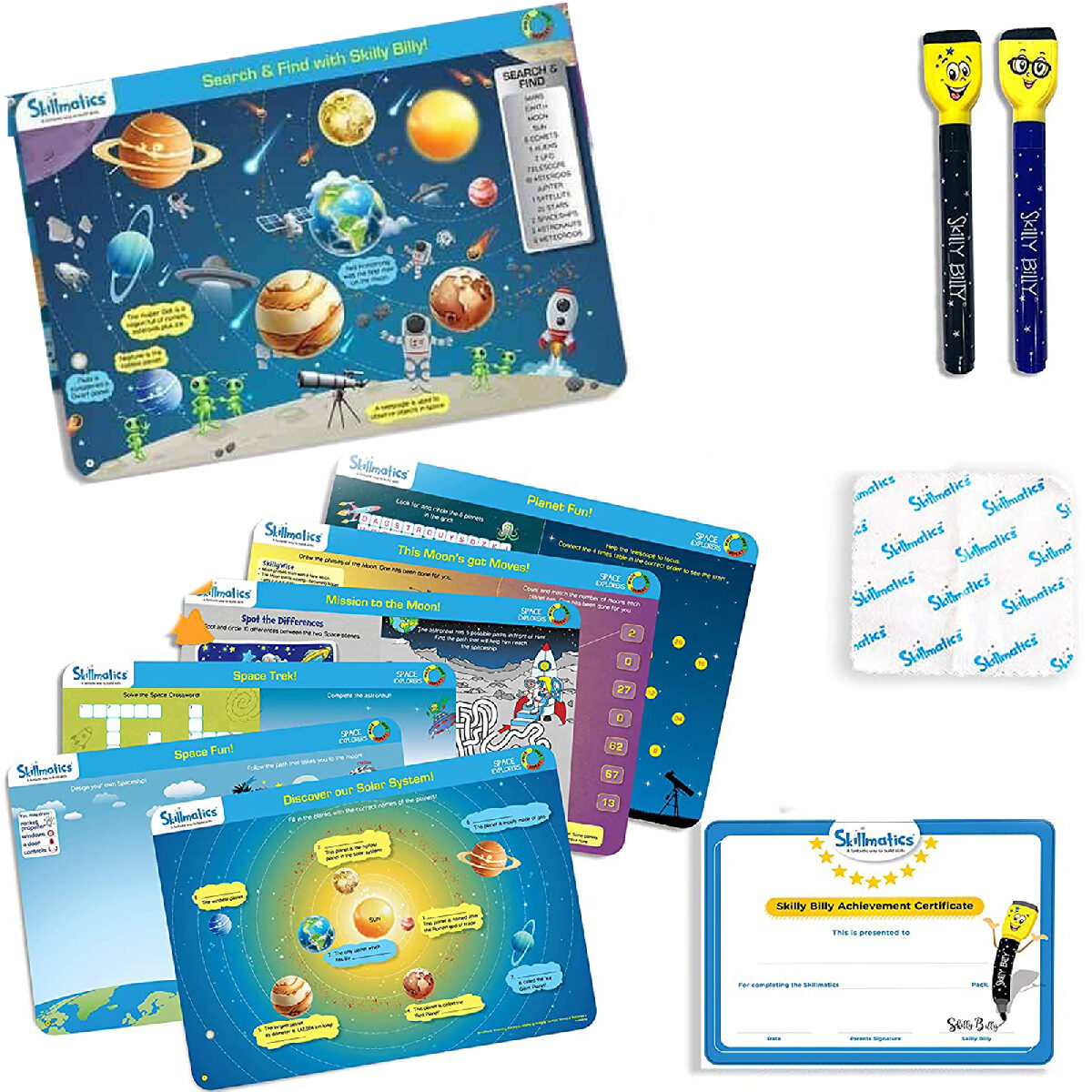
★★★★☆
For Families and Teachers | Age 4 to 9 | 1-3 Students | Price $$$
Skillsmatic Educational game Space Explorers contains 20 repeatable space-themed activities in 6 double-sided activity mats.
contains 20 repeatable space-themed activities in 6 double-sided activity mats.
This set comes with
- 2 dry erase pens
- Duster cloth
- Achievement certificate
Students learn key concepts like:
- Astronauts
- Planets
- Asteroids
- Comets
- Gravity
- Constellations
- Spaceships
The activities include:
- Identifying planets (the answers are provided at the bottom of the mat)
- Drawing constellations
- Looking for space objects
- Designing spaceship
- Solving puzzles and mazes
- Completing crosswords
- Comparing pictures and spotting differences
This activity set deserves three stars because
- The materials are beautifully illustrated and durable
- The content is well-thought, and the mats are well-made and reusable
- Children can answer the activity mats simultaneously or cooperatively with another student
- The activities can reinforce students’ concentration, creativity and knowledge about the solar system
- It can be used as reinforcement activity in the classroom
This set was advertised for children aged 6 to 9 years old, but I think the activities are easy for children in Grade 2-3. I believe this set is more interesting for children aged 4 to 7 years old. They can finish all the activities in 20 minutes.
Space Darts (Arber)
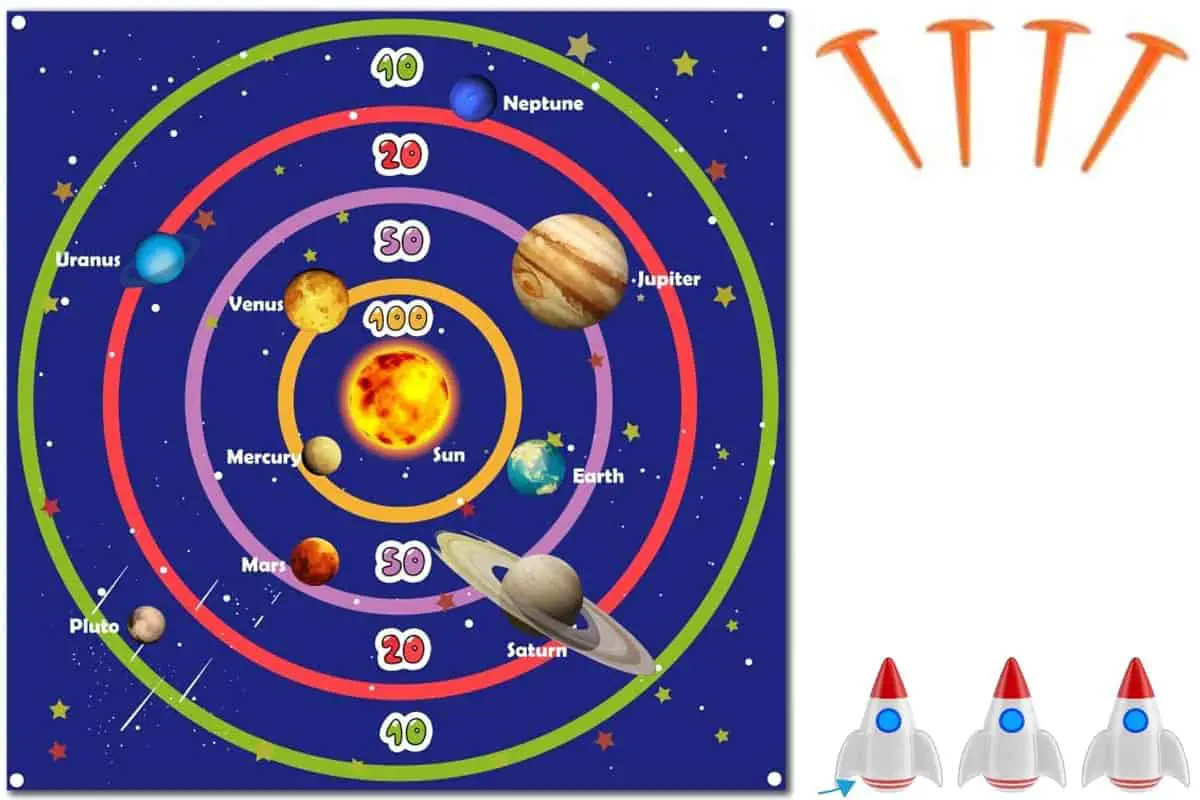
★★★☆☆
For Families and Teachers | Age 4+ | 1-3 Players | Price $$
In Space Darts, players take turns in throwing 3 darts that are shaped like rockets onto the center of the solar system board.
players take turns in throwing 3 darts that are shaped like rockets onto the center of the solar system board.
Each orbit of the planets has a corresponding value and the player with the highest score wins the game.
This game is composed of:
- A gameboard that has 48 inches (4ft) playing area
- 4 lawn pegs
- 3 inflatable rockets which measure 8.5 inches
I gave three stars because:
- It is easy to set up (the set comes with a small hand pump to inflate the rockets and the gameboard folds up nicely on the floor)
- Scoring is easy
- Players learn the names of the planets and its order naturally
- The mechanics is fast-paced and allows players to move and have fun as they wait for their turn
- The replayability is high
I think this is an exciting game to be used in the classroom. I recommend improvising cards with description of the planets then grouping the students to solve the mystery planet and they reveal their answer by throwing the dart on the orbit of the planet. The group with the highest score wins the game.
This game is suited to be played with children aged 4 to 8 years old.
Create A Scene Magnetic Playset-Solar System (Playmonster)

★★★☆☆
For Families and Teachers | Age 3 to 8 | 1-4 Students | Price $$
Create A Scene Magnetic Playset-Solar System is comprised of:
is comprised of:
- Magnetic game board
- Magnets for
- 8 planets (Pluto excluded)
- Earth’s moon
- Shuttle
- Space station
- Horse head nebula
- Galaxy
- Comet
- Asteroid
- astronaut
- Labels for each item
Children place the magnetic playing pieces on the gameboard which has an illustration of the orbits of the planets and the sun in the left upper hand corner.
The advantages:
- Students learn the names of the planets and their order
- They learn to associate the correct spelling of the words using the magnetic labels
- The game pieces are sturdy, bright, colorful and represent clearly the space objects
- Also good for solo play at home
- Teachers can use this set for one-on-one or small group classes
I recommend for children aged 3 to 8 years old because the game pieces are enough to teach the basic things they need to know about the solar system.
Edudingo.com is a participant in the Amazon Services LLC Associates Program, an affiliate advertising program designed to provide a means for sites to earn advertising fees by advertising and linking to Amazon.com. We also participate in other affiliate programs which compensate us for referring traffic.

